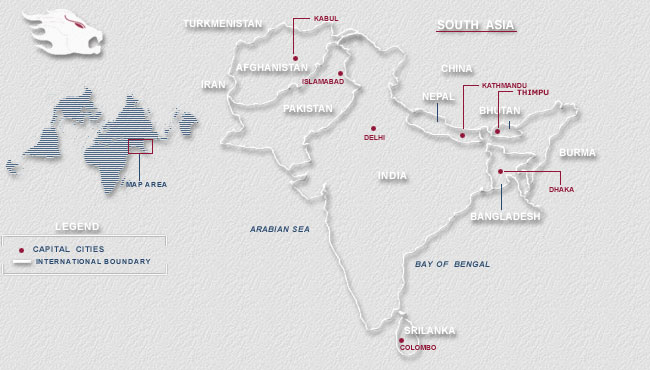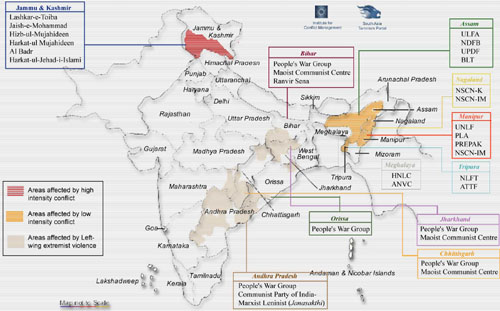India - Backgrounder on Conflicts

India has lost approximately 71,000 lives to terrorism and extremism over the last decade in the major irregular and sub-conventional wars that afflict the country. This is certainly cause for alarm, and creates an image of widespread breakdown of law and order – and this is an accurate picture of at least some parts of the country. Across most of its geographical expanse, however, India has remained by and large free of the modern-day scourge of terrorism, as of insurgency and other patterns of extremist political violence (see map). A study of data relating to civilian fatalities as a result of social and political violence in the country over the period September 1, 1999 – August 31, 2001, (Graph 1) indicated that nearly 36 per cent of all such fatalities occurred in parts of Jammu and Kashmir (J&K) alone as a result of the separatist proxy war in that State. Over 33 per cent were accounted for by a range of insurgencies and terrorist movements in India’s Northeast – and these were overwhelmingly concentrated in a small number of districts in four of the seven States in this region. A little less than 21 per cent of civilian fatalities resulted from Left Wing Extremist (referred to as Naxalism in India) and retaliatory violence in some areas of the States of Andhra Pradesh, Maharashtra, Madhya Pradesh, Orissa, Chhattisgarh, Jharkhand, Uttar Pradesh, West Bengal and Bihar. Barely 10 per cent of the total civilian fatalities were spread across the rest of the country, and only a small fraction of these were concentrated in the economically vibrant metropolii. While some micro-variations would occur from year to year, the broad trends in violence in the country remain consistent in pattern with the findings of this study. Separatism constitutes a primary demand of the movement in J&K, and of many of the groups active in India’s Northeast (though many Northeast groups do not have clearly defined separatist goals). There has been a proliferation of militant groups in recent times, with as many as 36 identified in J&K, and over 108 in India’s Northeast. Many of these are, however, insignificant gangs and some are now dormant. J&K is currently the most significant internal security challenge faced by the country (Graph 2), and four Islamist fundamentalist groups – all of them head-quartered in Pakistan – constitute the gravest threat in the State: Lashkar-e-Toiba (LeT) [recently renamed Jamaat-ud-Dawaa], Jaish-e-Mohammad (JeM) [recently renamed Khuddamul Islam], Hizb-ul-Mujahideen (HM), and Harkat-ul-Mujahideen (HuM). All these seek integration of J&K with Pakistan, and they have entirely replaced groups, such as the Jammu & Kashmir Liberation Front (JKLF), that sought Kashmiri Independence and who dominated the earlier phase of the militancy. A study of trends in terrorist fatalities suggests that at least a third of all terrorists killed are of foreign origin. The LeT is the terrorist arm of the Markaz-ud-Dawa-wal-Irshad (MDI), with its headquarters at Muridke in Pakistan. Its entry into J&K was first recorded in 1993 but it was after 1997 that it rose in the priorities of Pakistan’s Inter Services Intelligence (ISI). Indian government officials maintain that the ISI has been extending covert support to the LeT to carry out subversive activities globally after the US launched its war on terror against the Taliban and Al Qaeda. The directive to Lashkar is to concentrate their activities globally rather than in only a few countries, including India. On July 27, 2003, eight alleged Lashkar cadres, accused of planning terrorist acts in Jammu and Kashmir, were arrested during a series of raids around the Federal Capital of Washington. Three other persons, reportedly living in Saudi Arabia, were also named in a 42-count Justice Department indictment. The LeT has a specialised ‘suicide’ cadre, the fidayeen, who undertake high-risk missions against security forces and heavily guarded strategic targets. The first of these attacks targeted a residential complex of the Border Security Force (BSF) in Bandipore near Srinagar on July 13, 1999, towards the end of the ‘Kargil War’. The most spectacular of these missions was the attack on May 14, 2002, when three fidayeen of the Al Mansooran, a front outfit of the Lashkar, launched an attack on the Kaluchak cantonment in Jammu. 36 persons, a majority of them family members of SF personnel and other civilians, were killed, while 48 others were injured. Between November 1999 and December 2002, the Lashkar has carried out an estimated 50fidayeen attacks. LeT operations are characterised by a level of brutality that surpasses that of other terrorist groups in the State. Cases include the cold blooded murder of 26 people in Wandhama on the intervening night of January 25-26, 1998; the June 19, 1998, massacre of 25 members of a wedding party in Doda, Jammu; and, during President Clinton’s visit to South Asia, the Chattisinghpora massacre of 35 Sikhs on March 20, 2000. The JeM was set up in Pakistan in February 2000, by Maulana Masood Azhar. Azhar is closely connected with the Binori Seminary, the largest Deobandi madrassa in Pakistan, and was released on December 31, 1999, from an Indian prison in a hostage swap after the hijacking of the Indian Airlines Flight IC 814 to Kandahar, Afghanistan. The rise of the JeM has been rapid. The first of its more dramatic strikes occurred on April 23, 2000, when a youth rammed a car laden with explosives at the gates of the local army headquarters at Badami Bagh in Srinagar. The Jaish has also claimed credit for the rifle grenade attack on the J&K Secretariat building in Srinagar on June 28, 2001; and the attack on the State Legislative Assembly complex at Srinagar on October 1, 2001, using a car bomb – 38 people, including four fidayeen were killed in the latter. The JeM was also responsible for the attack on India’s Parliament in New Delhi on December 13, 2001, in which nine security force personnel and a Parliament staffer were killed. All the five terrorists involved in the attack were also killed by the security forces and were identified as Pakistani nationals. The JeM and the LeT are both closely connected with Osama bin Laden’s Al Qaeda, and are members of his International Islamic Front for Jehad against Jews and Crusaders (IIF). The HM is numerically the largest group in J&K, accounting for up to 60 per cent of the total terrorist cadres in the State, though Indian intelligence considers it to be responsible for only about 10 to 20 per cent of current terrorist strikes. The HM was founded in 1989 as the militant wing of the Jamaat-e-Islami on the prodding of the ISI, as an Islamic counter to the relatively indigenous and purportedly secular JKLF. The group is headed by Syed Salahuddin, and is headquartered in Pakistan. The HM was responsible for setting fire to the Muslim shrine of Charar-e-Sharief in 1995 and collaborated with the LeT in the Chattisinghpora massacre. It has also killed several moderate Kashmiri Muslims. The HM has, however, on occasion indicated a willingness to accept a negotiated solution to the Kashmir problem, and had declared a short-lived unilateral ‘ceasefire’ in J&K in July 2000. It has increasingly been marginalized in the terrorism profile of the State. Also, for quite some time, there has been serious infighting within the group. On March 2003, former HM ‘chief commander’, Abdul Majeed Dar, was killed in the Noor Bagh area of Sopore Township in north Kashmir. Dar’s killing was the culmination of a three-year battle for supremacy being waged by his followers against the faction led by Syed Salahuddin, the HM 'supreme commander' and chief of the 14-member United Jehad Council (UJC), a conglomerate of Pakistan-based terrorist organisations. Earlier, Dar was 'suspended' by the Salahuddin faction and replaced by Saiful Islam as the Hizb 'chief commander of operations' in Kashmir, on May 4, 2002. Within hours of Dar’s murder, clashes broke out at HM camps in Pakistan-occupied Kashmir (PoK) between the slain leader's followers and the faction led by Salahuddin. On July 10, 2003, Pakistani media reports indicated that the HM had split, with the faction owing allegiance to Abdul Majeed Dar joining the Hizb-e-Islami, after efforts for reunification by the front-ranking Kashmiri leadership and the Jamaat-e-Islami failed. Among the proliferation of terrorist organisations in India’s troubled Northeast, two stand out in significance: the United Liberation Front of Asom (ULFA) that seeks the secession of Assam, and the National Socialist Council of Nagalim (Isak-Muivah) [NSCN-IM] that has taken over the leadership of the longest insurgency in the region, seeking Naga independence. While violence by both these groups has seen a recent decline, their influence in the region is overwhelming. They run widespread networks of extortion, smuggling and other criminal activities, and also control substantial ‘overground’ business operations. The NSCN-IM has been engaged in negotiations with the Union Government under a cease-fire agreement that has been in place since August 1997. The latest round of peace talks between the Union Government and the NSCN-IM was held during January 2003 with the group’s leaders, Thuingaleng Muivah and Isak Chisi Swu, at New Delhi. ULFA has consistently rejected possibilities of a negotiated settlement. ULFA and the NSCN-IM have, moreover, continued to extend their spheres of influence in the Northeast region through low-grade violence as well as by training and arming a large number of other terrorist and proxy groups, and are supported by the ISI in their activities. No terrorist organisation in the Northeast has, however, sought to extend its sphere of operations outside the region till now. In contrast, the Islamist groups operating with Pakistani support in Kashmir do have a clear pan-Islamist agenda, and are known to have created a network of terrorist cells in a number of other States in India. While an occasional and dramatic strike has been engineered in various cities, including notably, Delhi, Bombay, Gandhinagar, Coimbatore and Hyderabad, over the past decade, they are yet to secure any noticeable and persistent impact on normal life in any of these areas. LeT, JeM, HM, and ULFA are among the 32 organisations banned under the Prevention of Terrorism Act (POTA) enacted on March 28, 2002. However, the immediate consequences of the Act and these bans have been negligible.  Graph 2 Total Fatalities in Major Conflicts NOTE: Figures of years 2002 and 2003 are provisional, compiled from news reports. |


No comments:
Post a Comment